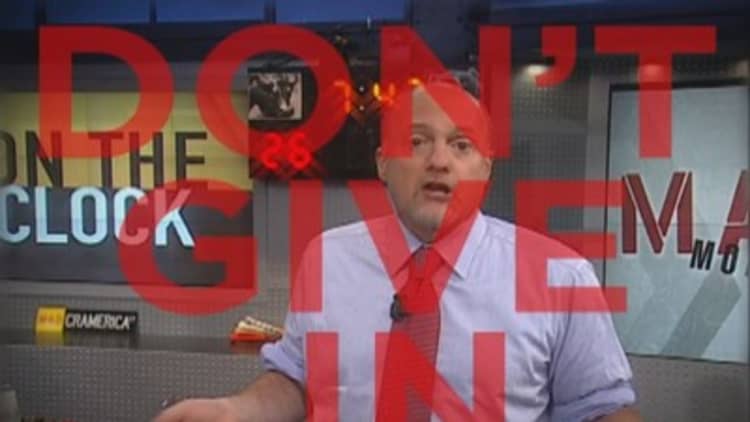
Look out the window of any office building on Wall Street and you'll see bulls licking their wounds while struggling to find their footing. Stocks suffered their biggest one-day decline since July on Thursday, with all 10 primary S&P sectors lower on the day and most down more than 1 percent.
Not only has the dropped for four of the past five sessions, it closed below its 50-day moving average for the first time since Aug. 15.
Cramer knows how upsetting these developments may be. However he's seen similar circumstances many times before and over the years he's developed a handful of strategies that he uses to navigate just these kinds of situations.
One of those methods involves taking the temperature of investor sentiment. And with the Dow Jones industrial average (.DJI) dropping by triple digits and stocks negative month to date, on Thursday sentiment was negative to scary.
Although your knee-jerk reaction may be to pare back, Cramer says that's a mistake. It may seem counterintuitive, but Cramer has found the best thing investors can do right now is resist the urge to sell. Find out why:
Read More
Although the market may feel horrible, peel back a few layers and you may be surprised by the positives.
Currently, the S&P is less than 3 percent below its record close; that's a long way away from correction territory, which is defined as a 10 percent drop from a peak. Also, the S&P hasn't had a correction since 2012.
Amid the sea of negatives, Cramer thinks it easy for investors to miss positives such as these. Therefore, he says, "do not sell in the midst of an awful decline, no matter how much you might want to," or you risk making emotional decisions.
And, as Cramer so often says, emotion and the market should be kept at arm's length.
"When the market turns south, when everything looks like it's falling apart, when the pressure's on, that's when people tend to screw up," Cramer added. To prevent mistakes, Cramer has developed a disciplined method for scaling both into and out of stocks. How does he do it?
Read MoreCramer's 4 point stock buying and selling system
Cramer also says that unless a so-called systemic failure event, such as the collapse of Lehman Brothers, is behind the selloff, then history sides with the bulls.
"Therefore, I wouldn't run away (from a selloff) because there might well be an opportunity for you to make a very big profit," Cramer said.
In fact, Cramer often looks for opportunities amid the decline. And across his career, as he scanned the market looking for buys, he's asked himself how the selloff impacted Bristol-Myers (BMY). Why does he ask that?
Read MoreCramer's Bristol-Myers theorem: What is it?
All told, Cramer thinks it's a mistake to fear a selloff. If anything, he would look at most declines as opportunities to buy favorite stocks at a lower price.
If you hold a diversified portfolio of stocks made up of quality companies with solid balance sheets, good prospects and strong industry position, Cramer says, over the long-term, you'll be just fine.
Reuters contributed to this report


